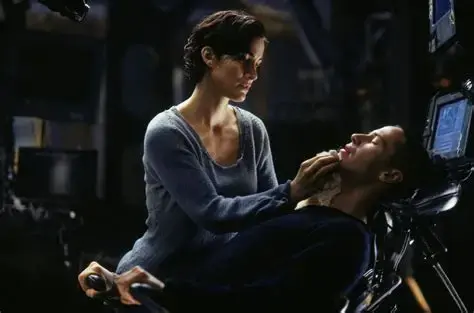The Matrix (1999)
- Soames Inscker

- Jul 12
- 4 min read

When The Matrix exploded onto screens in 1999, it didn't just entertain—it rewired the expectations of what science fiction, action, and cinema itself could be. Blending dazzling visual effects with philosophical depth, the Wachowskis’ visionary work became an instant cultural touchstone. At once a cyberpunk action film, a philosophical treatise, and a generational myth, The Matrix is one of the most influential and innovative films of the late 20th century.
Plot Overview
Thomas Anderson (Keanu Reeves) is a disaffected computer programmer by day and a notorious hacker named “Neo” by night. Haunted by cryptic online messages and the sense that something about the world isn't right, he is contacted by a mysterious figure named Morpheus (Laurence Fishburne). Morpheus presents Neo with a radical truth: the world as he knows it is an elaborate computer simulation known as the Matrix, created by intelligent machines to enslave humanity while their bodies are used as an energy source.
Offered a choice between remaining in ignorance or confronting reality, Neo chooses the latter—“the red pill”—and is awakened into the real world, a dystopian wasteland controlled by machines. As Neo trains with Morpheus and fellow freedom fighter Trinity (Carrie-Anne Moss), he learns that he may be “The One,” a prophesied figure who can bend the rules of the Matrix and lead humanity to liberation. But first, he must face the Matrix’s most relentless enforcer: Agent Smith (Hugo Weaving).
Performances

Keanu Reeves, already a bankable star, became a pop culture icon with his performance as Neo. His quiet, introspective style fits the character’s journey from uncertainty to purpose, and his physical commitment to the action sequences is impressive.
Laurence Fishburne lends gravitas and intensity to Morpheus, delivering dialogue that could have easily become parody with Shakespearean conviction. He makes Morpheus a mentor and a spiritual guide, full of calm belief and commanding presence.
Carrie-Anne Moss, as Trinity, introduced a new archetype for female action heroes—graceful, lethal, and emotionally complex. She is far more than a love interest; her role is integral to Neo’s evolution and the film’s emotional resonance.
Hugo Weaving, as Agent Smith, is mesmerizing. His deliberate, clipped speech and controlled menace turn a potentially generic villain into one of cinema’s most memorable antagonists. Equal parts terrifying and oddly funny, Smith is the perfect foil for Neo’s humanity.
Direction and Style

The Wachowskis brought a bold visual language to The Matrix, fusing anime aesthetics, cyberpunk dystopia, and Hong Kong action choreography into a sleek, unforgettable package. Their use of “bullet time” (slow-motion action captured through an array of still cameras) redefined cinematic spectacle. The green-tinted visuals of the Matrix world, paired with rain-soaked, monochrome real-world scenes, create a distinct visual dichotomy that reinforces the film’s central theme: illusion vs. reality.
Their direction is kinetic but purposeful, grounded in character and story even during the most elaborate fight scenes. The pacing is meticulous, the world-building immersive, and the thematic ambition undeniable.
Themes and Philosophy
The Matrix is far more than just an action film. It asks profound questions: What is reality? What does it mean to be free? Can we trust our perceptions? The film draws from Plato’s Allegory of the Cave, Descartes' skepticism, Buddhist philosophy, and postmodern existentialism, all while delivering shootouts and kung fu battles.
The central choice between the red pill and the blue pill has entered the cultural lexicon as a metaphor for awakening to uncomfortable truths. The film explores the seductive comfort of illusion and the painful clarity of reality, reflecting millennial-era anxieties about technology, control, and identity.
Action and Visual Effects
Few films have altered the landscape of action cinema like The Matrix. The choreography, masterminded by legendary martial arts coordinator Yuen Woo-ping, brought balletic elegance to sci-fi action. Gunfights, kung fu duels, rooftop chases—each set piece is executed with precision and style.
The film’s digital effects were groundbreaking at the time and still hold up today, not just for their novelty, but because they serve the story. Every effect, from dodging bullets to running up walls, reinforces the idea that the Matrix is a simulation—one that can be bent or broken.
Cultural Impact and Legacy
The Matrix was a box office smash and critical success, spawning two direct sequels (Reloaded and Revolutions) in 2003, a 2021 follow-up (Resurrections), as well as a franchise of video games, animated shorts (The Animatrix), and extensive fan theory discourse.
Its fashion—black trench coats, sunglasses, leather—became instantly iconic. Its catchphrases (“There is no spoon,” “I know kung fu,” “Welcome to the real world”) were everywhere. And its metaphors, particularly around control and awakening, have been interpreted (and misinterpreted) across political, philosophical, and technological spectrums.
Perhaps more importantly, The Matrix was a turning point for digital filmmaking and action cinema. Without it, there may have been no Inception, no John Wick, no Westworld, and certainly no explosion of virtual-reality-themed narratives in the early 21st century.
Conclusion
The Matrix is a landmark of modern cinema—a rare film that combines spectacle and substance, pop culture and philosophy, existential depth and bullet-spraying thrills. The Wachowskis crafted not just a brilliant science fiction narrative, but a full-blown cultural movement.
It remains as timely and provocative today as it was in 1999, a prescient reflection of our increasingly digital lives and the blurred lines between what’s real and what’s programmed.
Rating:
A groundbreaking fusion of philosophy, action, and visual innovation. Endlessly rewatchable, endlessly relevant. Welcome to the real world.






